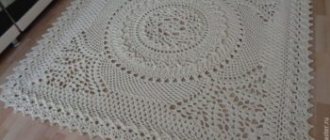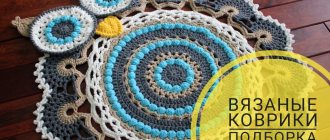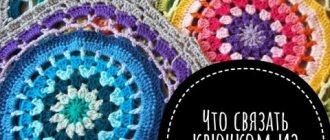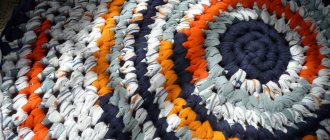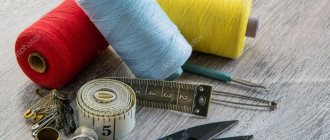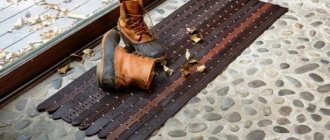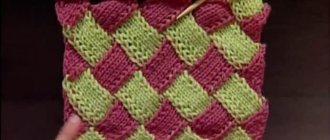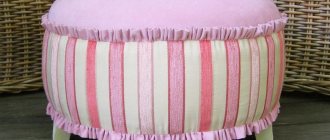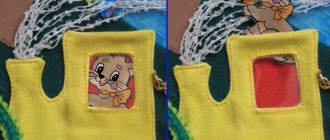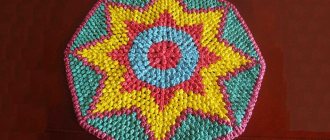In every family, over time there are many things that have become unusable. This includes children's clothing with stubborn stains, old T-shirts that have served their purpose, and jeans. But many thrifty housewives have found a way to breathe a second life into this rag. Crocheting rugs from leftover threads and rags, weaving them from various cords and ribbons, and making them using carpet-based techniques has become increasingly popular among them. Some methods for making such a home attribute are given later in the article.
Yarn preparation
Crocheting rugs from rags involves preliminary preparation of yarn from them.
It consists in:
- Choosing old things based on fabric structure that match each other.
- Cutting sorted raw materials into strips.
- Selecting ribbons by color (if necessary).
- Final preparation of yarn for knitting.
In order to correctly select the necessary material for making floor mats from rags, the first step is to sort it out and sort it by type of material. That is, put knitted items in one pile, denim in another, cotton in a third, synthetic in a fourth, and so on.
- After sorting the rags by fabric quality, you should prepare them for cutting. To do this, you need to trim all the seams, that is, along the bottom of the product and the sleeves.
- Next, lay the item on a hard surface and cut it into strips from one side seam to the parallel one, but not reaching it by 2-3 cm. This is necessary in order to create one continuous strip in the future.
- When performing this operation, you should know that it is recommended to cut dense fabric into narrow strips, and thin fabric into wider ones.
- After such a cut, in place of a continuous section of material, oblique cuts are made from one strip to the next, that is, the result should be a spiral-shaped continuous strip.
- If it breaks, it is advisable to sew the ends together by placing them on top of each other. Tying knots is not recommended. This will create inconvenience during further work and spoil the appearance of the finished product.
- After cutting the tape from very frayed fabrics, before winding it into a ball, it is advisable to treat its sections with fire. This technique will secure the cut threads and extend the life of the rug.
- The resulting yarn is wound into balls.
Material
Crocheted rugs, even with patterns, cannot be created if there are no threads. From ordinary knitting threads, round or square rugs are impractical, since they wear out quickly and are also quite thin.
Advice! An option is rag “yarn” obtained from old things. Knitting a rug from this material is a fun and creative task, since you will need to work hard to select the color and structure.
Old T-shirts, raglans, trousers and dresses will do. In order for the rug to have a uniform thickness, it is worth taking the same type of material. In the product, trim off dense areas such as pockets, collars, cuffs. The fittings should also be removed. Finished rag threads need to be wound into a ball and sorted by color.
Simple round crochet rug
Crocheting rugs from round rags is not difficult if a person knows how to hold a hook in his hand and knows how to make two loops - a chain stitch and a single crochet stitch or just one stitch.
In order to avoid a hole in the center of the rug, experienced craftswomen recommend starting work with a ring of yarn formed by twisting it twice around the index finger. With this method, after knitting the first row of loops, it is convenient to eliminate the gap in the ring by tightening the end of the yarn remaining from the entanglement. Next, this remainder is hidden inside the knitted posts and cut off.
- After knitting the first row, it is closed by connecting the outer column to the first, pulling the captured working thread under the two arcs of the initial loop through the loop on the hook.
- Next, to complete the second row, you need to knit 2 lifting air loops. This technique prevents the canvas from skewing and also maintains its flat shape.
- Then knit the second row with the same single crochets. But in order to create the correct round, rather than domed, shape of the rug, you need to make 2 stitches in each subsequent loop of the previous row. Finish the row in the same way as the first.
Each subsequent circular row is knitted similarly to the one below, but to maintain the flat shape of the rug, additions must be made. Their number and frequency are calculated individually. This depends on the number of stitches in the first row, the thickness of the material used and the knitting density. With existing experience and skills, the need for additional loops is determined visually.
After reaching the desired diameter of the product, the outer row is closed, secured and the end of the yarn is hidden inside the knitted loops.
Knitting rules
Before crocheting a rug for beginners with your own hands from rags, you should learn some rules and features of working with a crochet hook.
- Even if there are not many financial opportunities, threads (materials) and a hook must be selected correctly. Crocheting rugs is a simple task, provided that the right tool is selected. If it is difficult to do this yourself, then you should come to a specialized store with a sample of yarn, the seller will help you choose.
- Before starting the main work, that is, knitting a rug, you need to make a sample. Its size is approximately 5x5 cm. In this case, you should use the same yarn, hook, knitting pattern that will be used for the rug.
- Knit without tension, that is, without tightening the loops, otherwise the product will look ugly.
Round rug with braid
Another option for making a round rug is a combination of crocheting and sewing. This combined technique is used if the yarn is thick. It creates inconvenience during circular knitting. Therefore, to make such a rug, first a very long chain of air loops is knitted from prepared yarn. Then it is laid out evenly in a spiral, securing each subsequent turn with the previous one with a needle and thread. The result is a not too rough, but dense rug.
Floor rug made of round motifs
One of the interesting solutions for making floor mats is various combinations of round fragments. They can be done:
- from the same material in structure, but different in color range;
- from fabrics of different composition and color;
- from several types of patterns.
The motifs can be connected to each other both when knitting the outermost row of each fragment, and after they are completely knitted. It depends on whether there is a preliminary layout of the elements or whether it is drawn up during the knitting process, how many and what sizes the parts are prepared.
With bumps
This funny rug looks larger than a regular one and retains heat better. It will fit perfectly into the nursery environment, giving it comfort and originality. To make such a product:
- A column is made and several double crochets are knitted from it. It should turn out that they have the same vertex.
- There should be as many double crochets as there are segments of the carpet.
- Each column is knitted with a zigzag from the beginning of the next row.
Openwork rug
Crocheting rugs from rags using openwork hems has become quite a popular phenomenon in the interior of many homes. This is due to the fact that the “gaps” formed between the rows can be designed in a variety of ways. For example:
- You can stretch contrasting yarn or ribbon through the vertical constrictions;
- used to introduce finishing details in the form of leaves, flowers, ruffles, etc. into a standard pattern;
- During knitting, an LED cord can be inserted into some circular openwork rows. This will not only create coziness in the room, but will become an original addition to the interior.
For openwork rugs, it is recommended to use yarn of thin and medium thickness, since the finished product made from thick material will look awkward and rough.
Any pattern, as well as a diagram for its implementation, can be applied to floor mats. A wide variety of them can be found on the Internet. Round napkin patterns are also suitable for this. But too complex and ornate openwork should not be used.
Firstly, performing operations with a large number of loops will be difficult due to the thickness of the yarn.
Secondly, in places with a large number of posts or their combinations, compactions will be created, which will adversely affect the appearance of the finished product and will cause discomfort during direct use.
Below are some patterns for floor mats:
For experienced craftswomen
Those who have been doing needlework for quite a long time and have experience can create chic models without any problems by choosing intricate patterns. They use stitches that are difficult to knit; a novice craftsman will not be able to cope with them. Craftswomen who know their craft can easily combine such complex patterns as pineapples and cones, floral motifs with pom-poms, etc. Using a napkin pattern, create a unique rug, and its size can be increased by combining a pattern or inserting rows from another pattern into the pattern . The canvas will fit perfectly into the overall interior.
The nursery needs carpeting that is in harmony and matches the decor. When arranging the room, adults are obliged to take into account the wishes of the child. Children love it when their room looks colorful, like in a fairy tale. If you have already hung curtains, purchased a bright blanket, but have not found a suitable rug, handicraft mothers will be able to knit it, but not a simple one, but an unusual one, for example, in the shape of some animal. It's not that difficult; it's enough to correctly connect geometric shapes - squares, circles, rectangles, ovals, pentagons, rhombuses and other shapes.
Crocheted rugs are elegant, fashionable, popular and impressive. Any person who comes to visit you will be delighted with the original thing, because not everyone has such a miracle lying on the floor in their apartment. Surely they will want to place an order for you, which in the future can turn into a good part-time job.
Crocheted rugs are elegant, fashionable, popular, impressive
In the form of a scarf
Crocheting rugs in the form of a scarf from rags can be done in 2 options:
- longitudinal,
- transverse
The difference between these methods is that when knitting longitudinally, you must immediately set the desired length, since it will not be possible to increase it later. With cross knitting this possibility exists. The same applies to the width of the product. It can be changed in the longitudinal direction, but not in the transverse direction.
Since the production of rectangular rugs involves straight and reverse rows, it is recommended to choose double-sided patterns for them, that is, so that they look the same on the front and back sides.
If knitting is carried out using the most common method, single crochets, then in order to avoid compactions between the rows, with each subsequent knitting, the working thread should be grabbed not under the two arcs of the lower loop, but only at the back one. Thus, smooth horizontal or transverse stripes (depending on the direction of knitting) are formed on the front and back sides, created by the remaining front arcs.
Rectangular rugs with square motifs
You can also create a beautiful floor rug using numerous multi-colored elements or fragments that differ in the structure of the material used.
Their knitting pattern can be either circular rows or straight or reverse. This depends on the thickness of the yarn used. For thinner source material, openwork patterns will be acceptable. Motifs from straight and reverse rows are better suited to dense raw materials. The size of the fragments is determined individually and depends on the required parameters of the finished product.
The coupling of motifs with each other can also be done in two ways: when knitting the outermost row and after making a complete set of parts. The connection of separately connected motifs is done by crocheting or sewing with a needle and thread.
Pentagonal rug
A simple, but at the same time original solution is to make a pentagonal rug from an ordinary round rug. It is enough to make some calculations at the beginning of knitting. Before you begin making the first row around the starting ring, you should decide on the required number of loops, a multiple of 5. Depending on the thickness of the yarn, there can be 10, 15, and so on.
When knitting the second row, you should make constrictions from a certain number of air loops between the resulting five groups of loops. Their length is determined individually, based on the thickness of the material used.
When performing each subsequent circular row, do not forget about additionally adding loops in each first and final loop of a separate group. Their frequency is determined visually to avoid both the formation of a dome-shaped mat and the presence of tails.
After reaching the required diameter of the rug, the outer row is closed with a connecting post, the loop is secured, and the end of the yarn is hidden in the previously knitted rows.
Bright rectangular rug for a children's room
This cotton rug with bright colors and a cute round edging will lift the spirits of your household even on the coldest and cloudiest day!
We will need:
- yarn (100% cotton, 120 meters per 50 grams), 11 skeins of turquoise color (A) and 3 skeins of orange (B); second type of thread (100% cotton, 135 meters per 50 grams), 9 skeins of lemon (C) and 150 grams of pink;
- We work with crochet number 6.
The size of the finished product will be 78 x 120 cm.
Knitting density: 15.5 p. x 12 p. = 10 x 10 cm with the main pattern.
Basic pattern (designed for an even number of loops):
1 rub.: in each century. emb. R. do 1 s. without n., 1st p. without n. Prov. in the 2nd century. n. from cr.;
2 p.: 1 v. p., 1 p. without n in the 1st s. without n., *1 v. p., 1 p. prop., 1 p. without n. in the next With. without n., from * to *;
3 p.: 1 v. p., 1 p. without n. in the 1st s. without n., * 1 s. without n. next v.p., 1 s. without n. in the next With. without n., from * to *. 1-3 pp. perform 1 time, then 2-3 pp. we repeat constantly.
Circles
We fold the thread into a thread ring and knit it into a circle. R. With. without n.. At the beginning of each cr. R. issue additional 1 c. n., each cr. R. we finish 1 ss. in the 1st s. without n..
For increases we knit 2 s. without n. for 1 p. of the base. Increases issue. with an offset relative to approx. previous cr. R..
1 p.: 12 s. without n..
2-5 rubles: evenly approx. 6 p. without n. = 36 s. without n..
Scheme of work
We add 1 thread each of A and C, no. initial circuit of 122 V. p. and knit with the main pattern = 121 p. After 100 cm, cut off the yarn.
We also make 52 circles with yarn A-D, 13 pieces each.
Assembly
We sew the rug in circles along the short sides, not forgetting to alternate colors in random order.
Based
Crocheting rugs from rags can also be done on a base. This technique for making rugs is called carpeting. It consists of filling the warp cells with pieces of yarn or strips of fabric. The result is a fluffy, soft rug with a pile of a certain length.
In order to knit such a rug, you need a special base. Due to the repeated use of the finished product, it must be strong and wear-resistant, so Stramin is used for such purposes. But due to its high cost and difficulty in acquiring, experienced craftswomen have found an excellent way out of this situation.
They suggest making the base for the rug yourself. For this you will need strong cotton threads. Next, depending on the shape of the intended rug, as well as the thickness of the material used, you should knit a mesh with identical cells. This can be a fabric of regular alternation of single crochets and 1 chain stitch, or a single crochet stitch and 2 chain loops.
In the case of knitting round rugs, it is necessary to introduce additional cells into the mesh so that the base maintains an even horizontal position. The size of the mesh base must be equal to the final parameters of the product.
After making the frame, it should be carefully treated with waterproof glue. In this case, you need to ensure that all the cells inside are not covered with adhesive film. Then let the base dry and you can start making the mat itself.
It should be noted that a special hook is designed for knitting products in carpet technology, which is a slightly curved tool with a closing head and a thick wooden handle. This hook structure is necessary for the convenience of gripping yarn or material under the warp and forming a fastening loop.
In addition to knitting the base for the rug, you should also pre-prepare the yarn. This process involves cutting identical pieces of leftover thread or strips of fabric. The length should not be less than 6-8 cm, since in addition to the pile, its consumption is used to make a fastening loop. There must be many of them, because one unit is used to cover one cell of the base grid.
The color scheme in this technique can be varied. By using multi-colored pieces of fabric, you will get a bright rug with an abstract pattern. If a more clear pattern or ornament is provided, then it is necessary to prepare material of the appropriate color scheme. To make a rug with a pattern, the preliminary preparation also includes a diagram of the pattern in boxes for the convenience of translating it into reality.
To get started, you need to take the hook and place it under the broach of the first cell. Fold the prepared strip of fabric in half and grab the resulting loop with a crochet hook. Pull it over the base, holding the ends. Pull the connected ends of the strip through the loop formed. Use your hand to pull up the resulting pile, while securing the loop to the base. Exactly the same operation should be performed with each subsequent cell. For convenience, it is recommended to knit from right to left.
By filling one row of cells after another in this way, you get a continuous, fluffy and very soft floor rug.
Made from denim
Due to the fact that denim fabric is quite dense and rough, it is recommended to make strips of it for knitting floor rugs as thin as possible. But the problem is that this material is very friable. During cutting, as well as twisting into balls, its structure quickly collapses and the strength of the prepared yarn is lost. To avoid such troubles, after cutting denim products into strips, it is advisable to treat their cuts with fire. The threads sintered along the edges for a long time prevent the yarn from shedding and create more comfortable conditions for working with it.
Due to its density, denim yarn is difficult to crochet. The best option for making a rug from this material would be to prepare a chain of air loops, crocheted, which will subsequently be assembled into a spiral and secured in layers.
Original rug with footprints
If crocheting circles on the floor for beginners is no longer difficult, you can try crocheting interesting products with a pattern. The rug shown in the photo is best suited for a bathroom or hallway. It does not allow the feet to come into contact with the cold floor, dries quickly and is easily disinfected. To knit such a thing, you need to use the presented diagram. You will have to decide for yourself how to place the tracks. As well as what pattern to decorate the rest of the rug with. If this is a rug for the hallway in front of the front door, it is better to use a more durable material and choose darker colors.
As you can see, knitting an unusual rug with your own hands is quite simple. Moreover, there is no need to spend money on yarn. To create unique products using the technology described above, you can use old unnecessary things. The main thing is to take risks and try new technologies. Perhaps an excellent incentive will be the fact that crocheting circles on the floor from bags, satin ribbons, clotheslines and other things is now quite in demand. And some knitters make great money from such a craft. So why not make an exciting hobby an additional source of income?
Made from knitted fabric
Products made from knitted fabric are the most common and high-quality material for the manufacture of knitted floor rugs. It can be cut into strips of any width. The resulting yarn is soft, elastic, and durable. It does not crumble, but, when stretched, creates an even, twisted thread. When knitting from such yarn, very aesthetic and beautiful products are obtained.
Crocheting floor rugs from rags you don’t need in your wardrobe will help you not only gain handicraft skills, but also create additional comfort without financial expenses.
